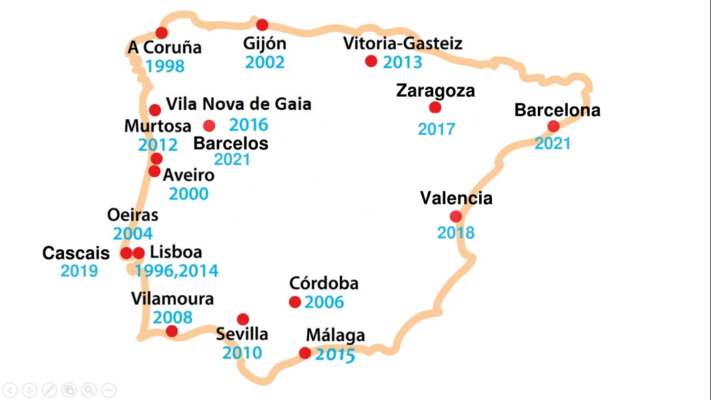Monthly Archives: March 2021
The XVI Iberian Congress
The XVI Iberian Congress: “Beyond mobility” on bikes and cities took place in Cascais, Portugal, from May 2nd to 4th, 2019. This annual event started back in 1996 thanks to the support of ConBici (Spanish Coordinator in pursuit of Bicycles) and FPCUB (Portuguese Federation of Cycle Tourism and Bicycle users). The Covid-19 made it impossible in 2020, and there is the prevision of continuing with it in Barcelos (Portugal) and Barcelona (Spain) in 2021 at the time I write this post.

Audiences enjoyed speeches about a variety of subjects such as improving communities to strengthen the bike movement, better accessibility, how bikes enhance economy, EuroVelo (the European bike line net to cross from one country to another without stopping pedaling), environment and health, raising cycle tourism or Velocity 2021. Moreover, participants uplifted their mood in the bike ride and local cuisine in the 3-days congress.
It concluded in:
-
The need of norms and laws in the bike building process to ensure security
-
The debate proposed bikes as part of economic accessibility and a boom of local economy in comparison of the car counterparts
-
The challenge of bikes in Africa, with special attention to the lack of bicycle infrastructures and the stigma of relating this way of transport with poverty
-
Transporting senior citizens in bikes, fro instance cargo bikes, helps benefiting local communities
-
Promoting bike use in schools makes societies less dependent of car and petrol
-
Such change is importantly improved when favorable laws and figures of reference, mainly parents, contribute
-
The congress also pointed out the need of technician training to create well prepared persons who design bike infrastructures
-
Another spot was the lack of reliable studies regarding the economic impact of bike on society and the hope of the BooST “Boosting Starter Cycling Cities” project will solve part of it
-
Moving from car cities to decarbonized cities
-
Promoting open data acquisition in regards of sustainable mobility
-
Intermodality
How to Ride Your Bike Like a Gentleman or a Lady
Delft train + bike station
One of the key concepts to fight against climate change is to allow people use non- or small-pollutant ways of transport. This fact, along with reducing space and infrastructures dedicated to noisy, contaminating transports, has been promoting in the most advanced countries for decades. One clear example is the Delft train + bike station (in The Netherlands) . This exemplar infrastructure enables thousands of people moving long distances under a comfortable, green model. Intermodality (1, 2) means just it: To transport people or things by using multiple modes of transportation. The good point in the Delft infrastructure is that the carbon footprint and the cost of using the station is considerably reduced in comparison with driving a car or a motorbike the same distance.
Why is so special this station? The Netherlands is well-known for being a paradise for urban cyclist and its developed railway system. So, they determined killing two birds with one stone. The Delft station was built thinking about the thousands of bikes one can see on a daily basis in the city. The result is a massive bike parking for 5,000 bicycles with natural light. A person arrives at the station by pedaling, locks her bike and takes the train. So easy, so powerful. What’s more, one can put it there for 14 days by free.
The modern bike parking sits of the floor and the train station is bellow it. But due to the fact of the enthusiasm people have shown with this infrastructure, there is an additional bike parking for 2,700 more bicycles close to the station. Well done!
Why American public transit is so bad
The Worst Bike Lane In The World?
The Highway Plan that Almost Destroyed Amsterdam – Plan Jokinen
Arturello di Pópolo
Arturello di Pópolo is one of the most impressive bikeclowns. This Argentinian man plays a show which is highly influenced by La Bicicleta, an originally humor, piece of art developed by Joseph Francis Jinarek. This Austrian bicycle winner suffered an almost crash when competing, i.e. the handlebar of his bike came off from the frame at high speed. Fortunately, thanks to a series of pirouettes and his balance skill, he could stop his bike, put his feet on the ground and open his arms. The public clapped enthusiastically and La Bicicleta show was born.
Arturo Chillida del Pópolo (Arturello di Pópolo) knew about La Bicicleta when he saw Jinarek son (Joe Jackson Jr.) performing it in a awards gala with the best bikeclowns back in 1976. He was so impressed that decided to perform its own La Bicicleta.
La Bicicleta consists in a two-characters play in which no word is pronounced. This apparently drawback does not avoid collecting a lot of laughs. It starts with a beggar clown who finds an alone bike. After checking the owner is far, he retains it. His funny problems start from this point, and I am not going to spoil them.
The impact of Arturello di Pópolo on La Bicicleta is considerable as the original play lasts about twelve minutes, whereas the di Popolo adaptation extends for forty minutes. However, their essence remains the same: Making people laugh similarly as all the other bikeclowns like Álvaro Neil do.
Here you can see some of his shows.